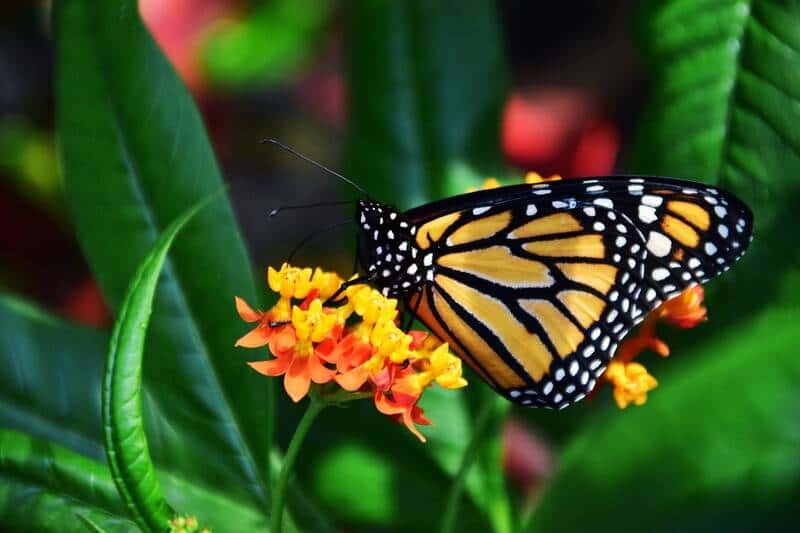Butterflies captivate us with their colorful, delicate wings fluttering from flower to flower. But underneath the beauty lies an incredibly complex, adaptive biological system. A common misconception is that butterflies have bones providing structure as humans do. In reality, butterflies have evolved a remarkably different skeletal system. Their body designs showcase the innovative ways nature promotes survival.
In short, we can say that butterflies don’t have bones, like humans and other mammals for example, but instead have an incredible skeletal system that supports their bodies and adapts them remarkably well for traveling and flight and all movements.
I. What Supports a Butterfly’s Body Structure?
Rather than an internal bone structure, butterflies rely on an external framework called an exoskeleton. Made primarily of chitin, a tough yet flexible polysaccharide, the exoskeleton encases the butterfly’s body in a protective armor.
This hardened shell maintains the insect’s shape, supports its vulnerable organs, and anchors its muscles. The primary function of the exoskeleton is protection, preventing desiccation and safeguarding against injury or predation.
Its rigidity combined with joints between segments enables butterflies to adeptly maneuver and fly.
Chitin, while yielding like plastic, is pound for pound stronger than steel. This high strength-to-weight ratio offers great advantages for small creatures like butterflies.
The carefully engineered design provides security without weighing the insects down. The exoskeleton has certainly proven itself to be a remarkable evolutionary innovation.
II. How Does an Exoskeleton Differ from Bones?
While both provide structural support, an exoskeleton, and our internal bones have significant differences:
- Location – The name gives it away for exoskeletons. As external frameworks, they encapsulate the body’s outer surface rather than residing inside it like bones.
- Composition – Exoskeletons contain chitin while bones are made of minerals like calcium and collagen. Chitin grants more flexibility.
- Growth – As insects develop, they must molt, shedding, and replacing their exoskeletons to allow for growth. In contrast, bones grow steadily along with vertebrate bodies.
- Protection – The exoskeleton safeguards against dehydration and environmental hazards in addition to impacts. Bones mainly provide internal structural support.
- Sensory Integration – Exoskeletons house sensory organs allowing insects to gather crucial information about their surroundings through touch, vibration, temperature changes, and more.
- Movement – Jointed segments of the exoskeleton facilitate insect motility. Bones rely on tendons and muscles for vertebrate locomotion.
So in summary, exoskeletons and bones serve analogous purposes but use vastly different designs and mechanisms to achieve those protective and supportive functions.
III. How Does a Butterfly’s Structure Change During Metamorphosis?
One of the most magical aspects of the butterfly lifecycle is their complete metamorphosis from larvae to winged beauties.
Caterpillars hatching from eggs initially have a rather alien-like appearance compared to adults. At this stage, they must focus on voraciously eating leaves to fuel their growth.
Caterpillars have an exoskeleton that protects their bodies but does not yet contain the wings, legs, antennae, or compound eyes of the butterflies they will become.
As the caterpillar rapidly increases in size, it molts this exoskeleton repeatedly to accommodate its expanding body. Once fully grown, the caterpillar finds a safe spot to begin its pupation.
Inside the protective chrysalis or pupa, the caterpillar radically transforms through histolysis and histogenesis. Histolysis breaks down the larval structures through the digestion of tissues.
Then the new adult tissues form via histogenesis. So while the future butterfly may appear to be disintegrating into an amorphous soup within the chrysalis, it is actually undergoing a carefully orchestrated process of reorganization and remodeling.
When this metamorphosis completes, the butterfly emerges from the chrysalis ready to take its first flight with a body now equipped with sensory antennae, six articulated legs, a feeding proboscis, and intricately patterned wings. What a magical transformation!
IV. What Are Butterfly Wings Primarily Made Of?
Butterfly wings contain layers of thin chitin membrane reinforced by a network of vein tubes through which hemolymph (akin to blood) circulates.
The wing veins provide structural support while transporting nutrients to nourish the wing tissues and muscles. But it is the microscopic scales on top of the chitin membrane that create the colors and patterns we admire.
These scales come in diverse shapes and can contain pigments or manipulate light through various optical effects. Some scales have ridges that diffract light, creating an iridescent sheen. Light scattering from intricate scale ultrastructures also generates bright structural colors.
The combined effect of many scales layered together produces the brilliant colors and mesmerizing designs we associate with butterfly wings.
Yet as elaborately decorated as they seem, butterfly wings are highly functional structures enabling powered flight.
Their delicate appearance belies the superb lightweight strength lent by the chitin biopolymer framework. And the morphological variety seen in different butterfly species’ wings allows for adaptations to unique flight specializations and environments.
V. Why Did Insects Evolve an Exoskeleton?
Insects developed the remarkable innovation of the exoskeleton over their evolutionary history as an adaptation to enhance the likelihood of survival. The exoskeleton serves multiple critical protective, supportive, and sensory functions:
- It acts as a suit of armor, shielding insects’ vulnerable internal tissues against threats.
- As a barrier, it prevents precious water loss, maintaining ideal hydration levels inside the insect.
- It provides rigid attachment points for muscles, enabling efficient locomotive movements.
- Sensory receptors embedded throughout the exoskeleton allow insects to rapidly detect changes in their environments.
Unlike vertebrates, insects could not easily accommodate an endoskeleton thanks to their small size. Molting the exoskeleton provided a means to grow by replacing the rigid covering with a larger version.
So while both options offer benefits, the exoskeleton proved far more suitable for insects’ requirements as tiny terrestrial invertebrates.
VI. Are There Structural Differences Between Moths and Butterflies?
Both belonging to the insect order Lepidoptera, butterflies, and moths share many commonalities. However, some physical characteristics differ between these winged cousins:
- Antennae – Butterfly antennae have a club shape while moth antennae lack the distinct club and may be featherlike.
- Wing Coupling – Moths have wing coupling mechanisms that link the front and hindwings. Most butterflies’ wings simply overlap.
- Resting Positions – Butterflies hold their wings vertically upright when at rest. Moths flatten their wings or fold them tent-like over their bodies.
- Body Shape – Moths tend to appear furrier and stouter whereas butterflies have smooth, slender bodies.
- Pupation – Butterflies form exposed chrysalises while moths often spin silken cocoons for secluded pupation.
Beyond physical variations, moths are typically nocturnal whereas butterflies fly during the day. And while they look dissimilar, both undergo complete metamorphosis from caterpillar to winged adult.
VII. How Do Butterflies Adapt Their Exoskeletons to Their Environment?
Butterflies exhibit amazing adaptability to tailor their exoskeletons to thrive in diverse habitats. For instance, those in cooler mountain regions evolve thicker, insulated exoskeletons to conserve heat.
In hotter climes, reflective scales help butterflies stay cool. Camouflage color patterns provide protection through concealment.
Some butterflies have developed foul tastes or even toxicity as defenses while some mimic the appearance of toxic species for protection.
In addition to evolutionary adaptations, butterflies make acute behavioral adjustments. For example, they will bask in sunlight to raise their body temperature or seek shade when overheated.
Their ability to replace their exoskeletons through molting enables the growth of larger bodies during favorable seasons.
The integration of physical, physiological, and behavioral adaptations allows butterflies to expertly modify their exoskeleton suits to survive and flourish in ecosystems worldwide.
In conclusion, the butterfly’s multifunctional exoskeleton provides critical structural support and protection, unlike our own internal bone frameworks. Their metamorphic abilities enable dramatic transformations from flightless crawlers to dazzling aerial artists. And specialized adaptations of the exoskeleton grant these delicate-looking creatures resiliency across habitats.
Truly understanding the biology behind beauty enhances one’s appreciation for butterflies and nature’s endless capacity for innovation.

